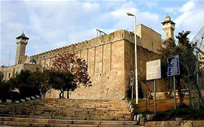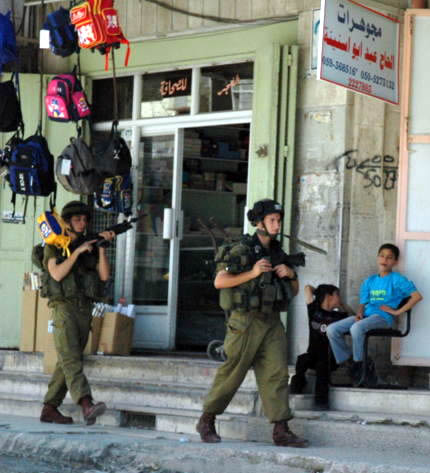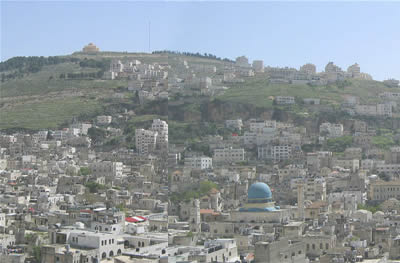


 I left Jerusalem at 9:30, taking the bus south to Hevron. Arrived an hour later and began to explore the shuk.
It was big and busy – a market for regular people, not tourists. Everyone was bargaining over spices, food, clothes, and I joined in,
speaking Arabic with the merchants. There were some good used clothes deals.
People came up to me and started conversations in Hebrew, which surprised me. Did this indicate a lack of resentment, positive feelings toward Israel?
I left Jerusalem at 9:30, taking the bus south to Hevron. Arrived an hour later and began to explore the shuk.
It was big and busy – a market for regular people, not tourists. Everyone was bargaining over spices, food, clothes, and I joined in,
speaking Arabic with the merchants. There were some good used clothes deals.
People came up to me and started conversations in Hebrew, which surprised me. Did this indicate a lack of resentment, positive feelings toward Israel?
At
מערת המכפלה
– the Cave of Machpelah – I watched Jews and Muslims praying side by side.
Both traditions revere this holy place as the burial site of Adam & Eve, Abraham & Sarah, Isaac & Rebekkah and Jacob & Leah.
For Jews, this is the one of the holiest of sites, second only to the Temple Mount. It was beautiful to see Muslims and Jews praying together.
 I visited another tomb, the Tomb of Avner (see 2 Samuel 3) and in the distance saw Herodian outside the walls.
Then I caught the bus back to Jerusalem, a one hour trip. Changed buses and went north a half-hour to Ramallah.
I visited another tomb, the Tomb of Avner (see 2 Samuel 3) and in the distance saw Herodian outside the walls.
Then I caught the bus back to Jerusalem, a one hour trip. Changed buses and went north a half-hour to Ramallah.
The West Bank is much more populated in the north, and also more affluent. Ramallah appeared to be the wealthiest
West Bank town I had seen so far, with nice cars everywhere, comfortable houses, attractive stores.
I wandered around for an hour and lunched on fresh pita and cus-cus - 15 shekels!
I continued my bus trip north, catching the 3:40 bus up to Nablus. I saw a number of Jewish settlements, and suddenly our bus was stopped by Israeli soldiers.
They boarded the bus, walking down the aisle, scanning everyone, carrying big guns. I don’t recall them mistreating anyone, but their presence
was quite intimidating and the power chasm between the two groups, the riders and the boarders, was quite clear.
The ride to Nablus was some of the most beautiful country I have seen here. Gorgeous mountains, undeveloped rural countryside with few settlements.
I arrived in Nablus at 4:40 and began searching for Old Schem. While I was walking along one road up a hillside I was surprised to see a few rocks
go sailing over my head. I turned around and saw some young boys in the distance throwing stones at me. I suppose they mistook me for an Israeli.
In town I met a number of people who spontaneously told me their stories of mistreatment by Israel authorities.
 Sometimes they seemed a bit strident; but in retrospect I can see there was much more to it.
These were frustrated people who felt a deep sense of injustice, desperate to tell their stories to any outsider they might happen to meet.
When I tried to change the topic, they brought it back to the political situation again. "Politics is our life here," one person told me.
Sometimes they seemed a bit strident; but in retrospect I can see there was much more to it.
These were frustrated people who felt a deep sense of injustice, desperate to tell their stories to any outsider they might happen to meet.
When I tried to change the topic, they brought it back to the political situation again. "Politics is our life here," one person told me.
I could not find Old Schem, so I went into the city. God always provides: while in town I encountered some of my Samaritan acquaintances sitting
on the sidewalk who invited me to their synagogue.
I met Abd, a Samaritan priest, at the Synagogue. He invited me to come home with him and I spent the night at his house.
Abd believes in his people, but is honest about the changes that have developed in the religion down through the ages.
For instance, when I asked about wearing totafot, something prescribed in the Torah and continued by observant Jews today, he said,
“Ah, you’re right!” He explained that people stopped wearing totafot because of persecution.

Abd wants to go to America and teach about the Samaritans in order to raise economic support to build a hospital.
He points out that Christians can see an incarnation of their Scriptures—the Good Samaritan, the woman at the well—in the present-day
community of Samaritans. Abd is passionate about helping his people, and we had a delightful evening
sitting on his porch and discussing faith. I see Abd as something of a neo-orthodox representative of his tradition.
Later I went downstairs and sat in on Yosef’s Hebrew tutorial. He is teaching the language to three young men who are applying for jobs with Israeli companies -
Israeli jobs are a good economic opportunity. (J. Migdal writes that this is a means of securing the
occupation's grip, by "not creating an indigenous West Bank infrastructure outside of the agricultural sector.")
Yosef is easy to relate to, and I really enjoyed spending time with him.


Rose 4:40. Ate breakfast, left a letter for Yosef, then hit the road.
7:35 got hitch, arrived Tulkarm at 8:00 and wandered around.
Returned home through Sharon Junction, and up the coast.
